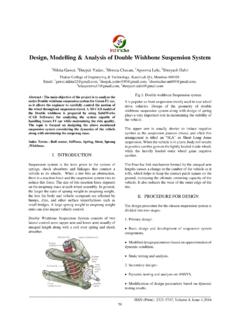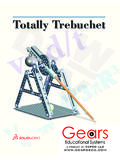Transcription of STRUCTURAL ANALYSIS OF EARTH-BAG SYSTEMS
1 STRUCTURAL ANALYSIS OFEARTH-BAG SYSTEMSENGS 88 Honors MalikFaculty Advisor: Professor Vicki V. May28thMay 2013 AGENDA Background Project Goals Design Methodology Construction Shake Table Testing Observations and May 2013 Observations and Results ANALYSIS Development of CAD Models SolidWorks Simulations Conclusions Recommendations for Future Work Acknowledgements2 WHAT IS AN EARTH-BAG system ? Masonry wall in which the building blocks are earth -bags: sturdy sacks filled with inorganic material (soil).Reinforcement Techniques: Barbed wire is often placed between the coursesto improve friction. Rebar and twine are hammered in to provide more resistance against overturning. EARTH-BAG walls are finally Project Goals Design Methodology Construction Testing Results ANALYSIS SolidWorks Conclusions Future May 20133 Advantages: Inexpensive method to create structures that are both strong and can be quickly built.
2 Highly insulated walls with excellent performance in humidity. Eco-friendly! Provides Greater Resistance to Earthquakes.(NEED TESTING TO VERIFY THIS CLAIM) Historically, EARTH-BAG walls are used as military bunkers and temporary flood controlling OF EARTH-BAG SYSTEMS earth -bags are also one of the most popular choices for constructing affordable housingin developing May 20134 Background Project Goals Design Methodology Construction Testing Results ANALYSIS SolidWorks Conclusions Future Recommendations Dartmouth s initiative to design and implement affordable housing solutions for Haiti. Professor Vicki May is part of a team of designers creating innovative ways to reduceconstruction costsand make implementation simpler.
3 Challenge is to ensure safetyof THE $300 HOUSE PROJECT Challenge is to ensure safetyof proposed structures. Prototype houses are being built in Haiti. Team led by Professor Jack May 20135 Background Project Goals Design Methodology Construction Testing Results ANALYSIS SolidWorks Conclusions Future Recommendations Blog post in the Harvard Business Review by Professor Vijay Govindarajanand Christian Sarkar challenging designers to create a house for the poor, ideally for $300. ( ) The Design Challenge winners attended a Design Workshop at Dartmouth in Jan $300 HOUSE May 20136 Background Project Goals Design Methodology Construction Testing Results ANALYSIS SolidWorks Conclusions Future RecommendationsPattiStouter,oneofthewinn ersofthe$300 HouseChallenge, 71 GROUP PROJECT Professor May presented the $300 House Challenge to her students in ENGS 71 ( STRUCTURAL ANALYSIS ) in Spring 2012.
4 I was a member of the group investigating the STRUCTURAL viability of May 20137 David Connolly 13 Steven Jin 12 STEP 1 STEP 2 STEP 3 Background Project Goals Design Methodology Construction Testing Results ANALYSIS SolidWorks Conclusions Future Recommendations Our project goal was to investigate the effectiveness of rebar as an added reinforcement. We built two walls scaled down to 40%. One wall had rebar hammered through at regular intervals. The test setup included a hydraulic jack ENGS 71 GROUP May 2013 The test setup included a hydraulic jack connected to a force gage. A ruler was fixed along the jack to measure the displacement. We measured the in-plane and out-of-plane displacements of each Project Goals Design Methodology Construction Testing Results ANALYSIS SolidWorks Conclusions Future Recommendations In order to compare our experimental results with theoretical predictions, we needed to experimentally determine the Young s Modulus of an EARTH-BAG .
5 We used the Instron to compress a single EARTH-BAG . The Force vs. Extension data was used to create a Stress Strain plot. The slope of the linear portion of the graph (Young s modulus) was determined to be approx. 20 71 GROUP May 2013 The wall was modeled as a simply supported beam with maximum deflection at the center of the wall. Our test results were inconclusiveand our experimental readings did not match our NEEDED A MORE ACCURATE APPROACH TO Project Goals Design Methodology Construction Testing Results ANALYSIS SolidWorks Conclusions Future Recommendations Build scaled down models of EARTH-BAG corner walls (regular corners, piers and buttresses). Test effectiveness of reinforcing corners using a shake table.
6 Measure real-time deformations of the walls up to failure and scale back up to determine the deformations of real-life structures. Compare max. displacements with PROJECT May 2013 Compare max. displacements with theoretical predictions. Develop a CAD model of the walls and use SolidWorks Simulation to determine the max. deflections in each type of corner Project Goals Design Methodology Construction Testing Results ANALYSIS SolidWorks Conclusions Future Recommendations Ian Herrick 13 built a shake table for Professor May during the Summer 2012 term. The weight limit of the table determined the scale factor of the corner walls. Max. Weight allowed was approx. 100 lbs. The appropriate scale factor was 1/6thof the real-life wall.
7 I built two walls of each corner type. The wall dimensions were 20 x 20 square inches. Each bag was inches wide, and the length of the bags DESIGN May 2013 Each bag was inches wide, and the length of the bags varied from 5 inches to 15 inches depending on location and type of corner wall. 1/8thin. thick 24 x 24 in2sheets of plywood were used as the base of the walls. The total weight of each wall was calculated to be between 50 60 Project Goals Design Methodology Construction Testing Results ANALYSIS SolidWorks Conclusions Future RecommendationsShake Table Specifications:Total travel: inches Table Dimensions: 24 in. by 24 in. Total Weight: 325 lbs. Weight Limit for Testing: 100 lbs.
8 Frequency Range: 0 Hz to Hz Motor: Baldor HP, 90 V, DC GearThe Curious Case of scaled down models! The earth -bags were not the only parts of the model that needed scaling. Barbed wire and rebar also needed to be scaled down. Required barbed wire diameter = in. Required rebar diameter = May 201312 Background Project Goals Design Methodology Construction Testing Results ANALYSIS SolidWorks Conclusions Future RecommendationsRegular Corner Pier ButtressCORNER WALLS CONSTRUCTIONG etting the right soil (Ball Drop Test) Wet soil just enough to hold together. Form into 4 cm ( inch) diameter balls. Drop them from m (5 ) height onto a hard surface.
9 If they flatten only slightly the soil has too much clay and needs more sand. If the balls develop cracks (break into 4 or 5 pieces), the soil is good for earth -bags. If the balls shatter, the soil does not have enough clay or May 2013 Plastering (2-layer Process) Layer 1: Mixture of Soil and Straw Provides a rough, flat surface on which the plaster can stick and harden easily. Layer 2: Plaster of Paris Used a 2:1 ratio of water to Project Goals Design Methodology Construction Testing Results ANALYSIS SolidWorks Conclusions Future t building a smaller model be easier? Answer: Yes and No. Less labor-intensive, but more time-intensive. The polypropylene woven bags needed to be cut down to size and then stitched to form a bag.
10 (Time sink. The sewing machine kept breaking down!) I had to use a tablespoon to fill each bag, and the handle end CORNER WALLS May 2013of a hammer for tamping the soilfirmly inside the bags. (Another time sink!) The in. diameter wire had to be cut into barbed pieces using a wire cutter. (Yet another time sink!) Took me 6 weeks to build 6 walls!14 Background Project Goals Design Methodology Construction Testing Results ANALYSIS SolidWorks Conclusions Future Recommendations Testing took place on November 20th, 2012. Conducted by Awais Malik and Ian Herrick. The wooden base of the walls were bolted to the shake table. One side of the corner walls was perpendicular to the direction of motion.








